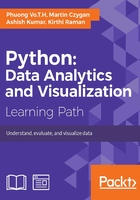
Chapter 4. Data Visualization
Data visualization is concerned with the presentation of data in a pictorial or graphical form. It is one of the most important tasks in data analysis, since it enables us to see analytical results, detect outliers, and make decisions for model building. There are many Python libraries for visualization, of which matplotlib, seaborn, bokeh, and ggplot are among the most popular. However, in this chapter, we mainly focus on the matplotlib library that is used by many people in many different contexts.
Matplotlib produces publication-quality figures in a variety of formats, and interactive environments across Python platforms. Another advantage is that Pandas comes equipped with useful wrappers around several matplotlib plotting routines, allowing for quick and handy plotting of Series and DataFrame objects.
The IPython package started as an alternative to the standard interactive Python shell, but has since evolved into an indispensable tool for data exploration, visualization, and rapid prototyping. It is possible to use the graphical capabilities offered by matplotlib from IPython through various options, of which the simplest to get started with is the pylab flag:
$ ipython --pylab
This flag will preload matplotlib and numpy for interactive use with the default matplotlib backend. IPython can run in various environments: in a terminal, as a Qt application, or inside a browser. These options are worth exploring, since IPython has enjoyed adoption for many use cases, such as prototyping, interactive slides for more engaging conference talks or lectures, and as a tool for sharing research.